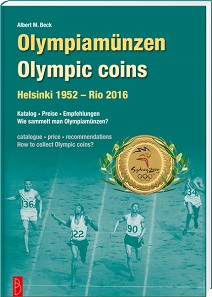Albert M. Beck, Olympiamünzen – Olympic Coins. Helsinki 1952 – Rio 2016. Battenberg Verlag, Regenstauf 2016. 192 pages with color illustrations throughout. Paperback. Thread stitching. 17 x 24cm. ISBN 978-3-86646-127-7. 29.90 euros.
Since 1951 Olympic Coins have been issued. While they were minted individually as commemorative circulation coins at first, Germany took advantage of its large issue, comprising six different types in two qualities and made by four mints, to have the citizens partly pre-finance the games through the seigniorage.
With the coin collector boom Olympic Coins became a promising business model which came to an abrupt end as a result of the silver price plummeting after the Moscow Olympics. Those who had bought the elaborate blue velvet boxes could consider themselves lucky if, when trying to re-sell them four years later, they obtained at least a fraction of the former purchase price. Silver had fallen by more than 90% – and there was no numismatic value to the strikings because the mintage had by far exceeded the number of potential collectors.
It took quite some time for the market of Olympic Coins to recover. But, it did recover, thanks to a reasonable issue policy in the 80s and 90s. Who wants to learn how the Royal Canadian Mint and the British Royal Mint sounded the death knell for the Olympic Coins as a collector field afterwards, should buy the catalog of Olympic Coins by Albert M. Beck. With this book, he not only submits a very beautiful and lavishly illustrated compendium of Olympic Coins up to and including 2016 but also presents a critical review of a failed issue policy.
Albert M. Beck is predestined to write this catalog. For decades, he has been a member of the IOC’s commission that decided upon collector issues. In this capacity, he was able to closely observe the coin program of many Olympiads from their initial stages to their realization. And so the catalog he offers to the collector is a very special book.
It contains a short but highly informative introduction, followed by a comprehensive catalog with illustrations throughout. Every coin type is accompanied by a current market value. Entry in this catalog only found those coins that were issued by the Games’ host country. Additionally, the catalog includes a section of commemorative coins that were minted on the occasion of the 100th anniversary of the modern Olympic Games. An itemization according to the numbers of issued coin types rounds out the catalog.
To anybody interested in modern Olympic Coins, this work is a standard reference that deserves a place in every library. And because of its introduction, the book ought to be given to every new member of a mint’s marketing committee. Perhaps this can make outsiders realize, too, that coins are not at all a product just like any other.




